Persian Aubergine Stew with Black Lime
A warming Persian stew of roasted aubergines, slow-cooked in a tomato and black lime sauce until velvety and fragrant. Enjoy the aubergine stew hot or cold with plenty of toasted pitas or fluffy flatbread.
This Persian-inspired aubergine stew infuses velvety roasted aubergine chunks and earthy lentils with a fresh citrus kick from black limes.
Serve the aubergine stew with fluffy flatbreads – it’s guaranteed to lift your spirits on a gloomy day.
Or enjoy it at room temperature with toasted pita triangles and a zesty chopped salad on a sunny afternoon.
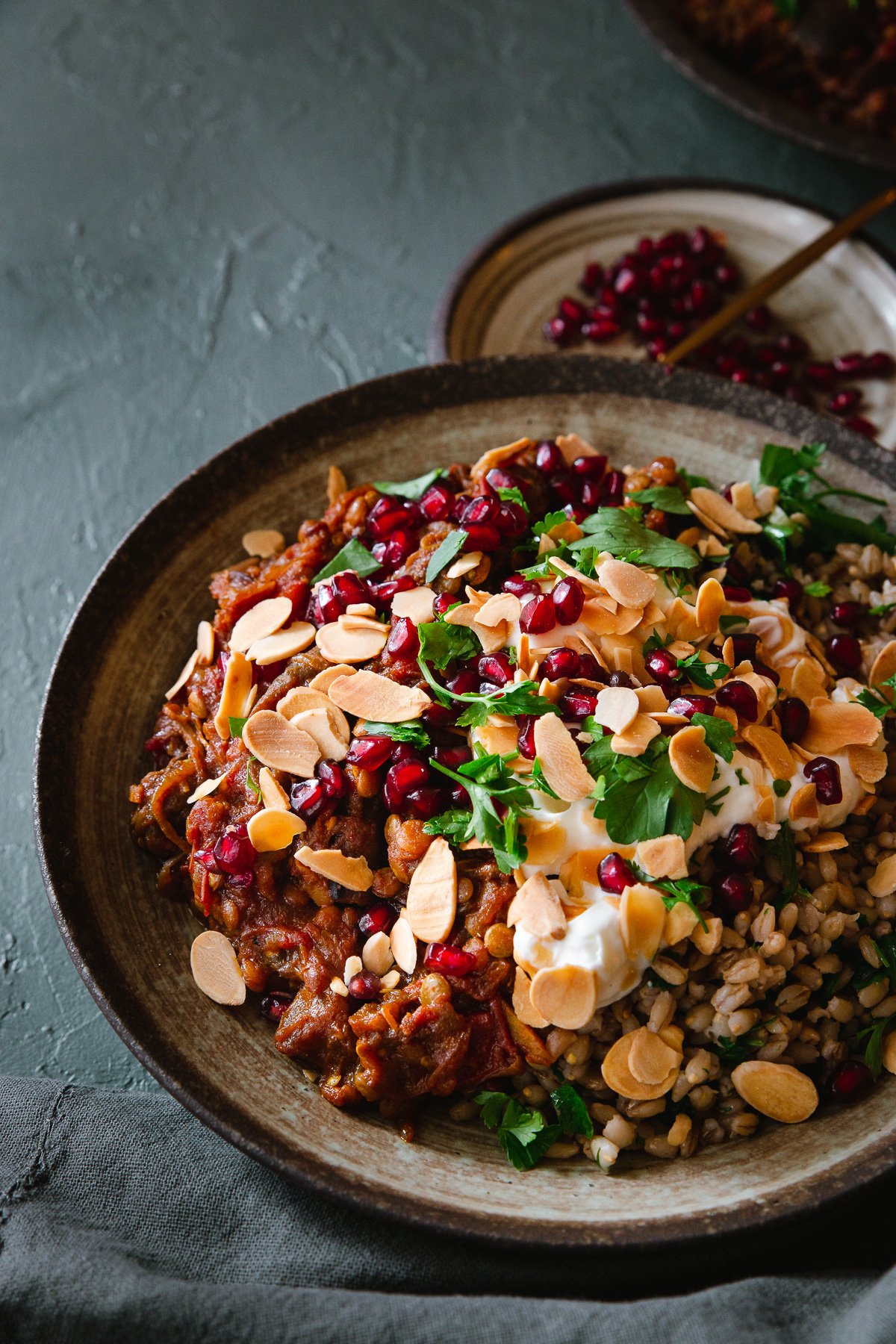
What are black limes?
Black limes are also called dried limes. And they are just that. Dried Limes. The limes are blanched, chilled and dried until dark in colour and light in weight, but loaded with flavour.
If you can’t find black limes at the store, you can absolutely make black limes at home. And if you really can’t wait another week before making this creamy eggplant stew, go ahead and substitute fresh lime juice and zest at the end of cooking. It still adds a lovely acidic kick even though it doesn’t have the same complex citrus flavour of dried limes.
That said, I do recommend putting in that extra effort to make your own black limes. At the very least add ‘Make Black Limes’ to your list of things to do next summer. They are so easy to make and bring pure citrus magic to the table!
Make your own black limes at home: How to make black limes
Vegetarian khoresh bademjan
Khoresh bademjan – the Persian aubergine stew (or eggplant stew) that inspired this dish – traditionally contains meat, often lamb or beef. But this meatless version is packed with Persian flavour. And the hearty stew hits all the comfort food spots.
Traditional khoresh bademjan calls for fried aubergine wedges. But this Middle Eastern aubergine stew recipe takes a healthier route with aubergine wedges charred in a hot oven.
The smoky roasted chunks of aubergine flesh get a slow braise in the black lime and tomato sauce over low heat. And the result is a flavourful vegan eggplant stew with an indulgent velvety texture.
I am sure you can also pull out the slow cooker for the second cook (let me know in the comments if you do!). Just don’t skip the aubergine oven roasting step. There are few things as unappetising as undercooked aubergine.
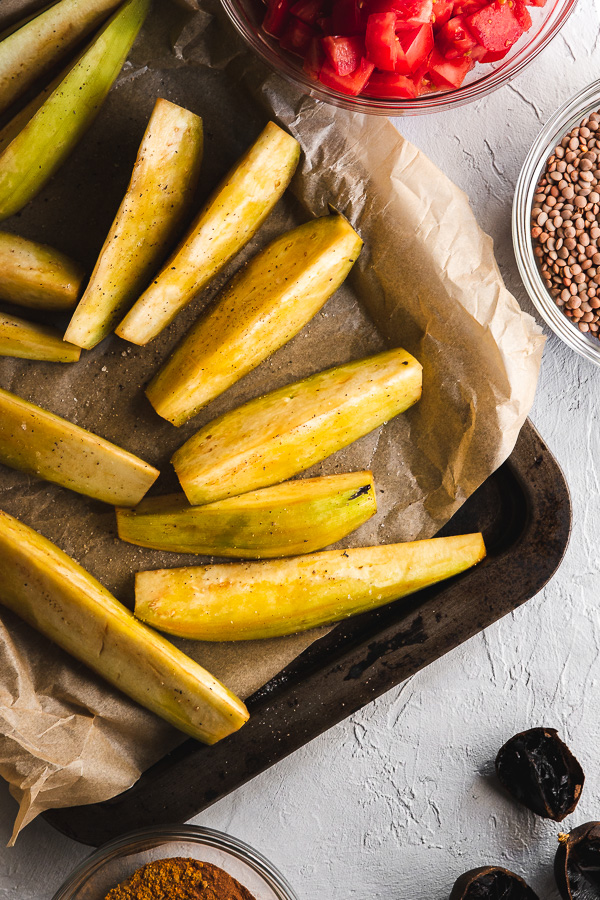
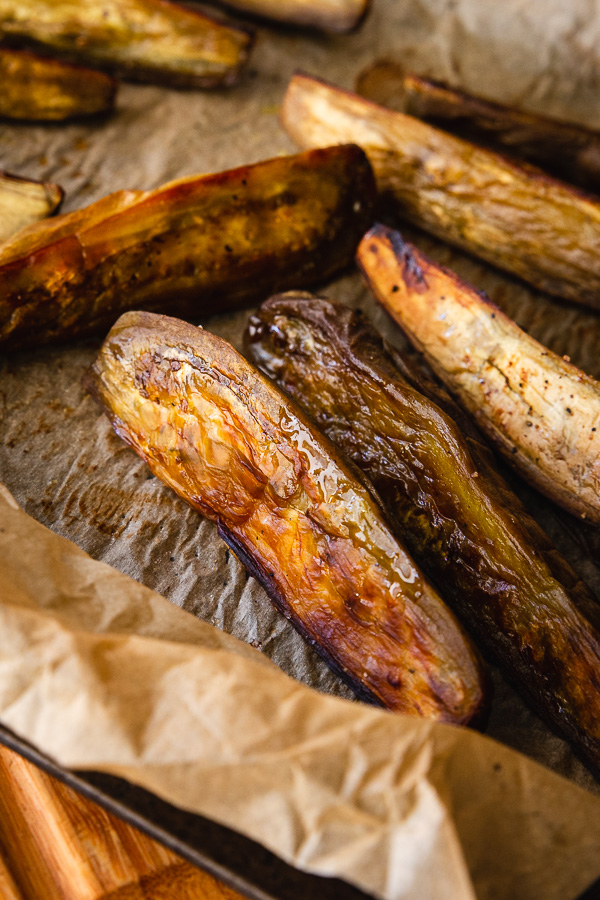
Ingredients & substitutes
- Aubergines (Eggplants): I use four medium-sized aubergines. You can use small or large aubergines as long as you have roughly 900 grams (2 pounds) of raw aubergine chunks after trimming and cutting the aubergines.
- Black limes: These magical spheres add a deep citrus flavour to the dish. But you can, instead, stir fresh lime juice into the aubergine stew at the end of the cook. And top the finished dish with lime or lemon zest for extra citrusy depth.
- Olive oil: The recipe calls for six tablespoons of oil. It may feel like a lot, but it gives the aubergine flesh a luscious texture. I use extra virgin olive oil.
- Onions: Normal onions, sliced very thinly, will do just fine. But you can always use red onion or shallots if that is what you have.
- Garlic: Four cloves of garlic may seem like lots of garlic, but this recipe creates a large batch of hearty stew with gentle savoury garlic notes.
- Spices: I use a combination of ground cumin, turmeric and cinnamon. These earthy spices are ubiquitous in Persian cuisine and bring warm comforting flavours to the stew, but you can substitute what you prefer.
- Tomato paste: I always have tomato paste in the house, but you can swap it for tomato puree if that is what you have. Or swap it for some rose harissa paste if you want to bring some heat.
- Tomatoes: Diced Roma tomatoes work well, so do tinned whole tomatoes or crushed tomatoes. Four Roma tomatoes are less than a tin of tomatoes, but go ahead and use a whole tin. This recipe does not require meticulous precision. You can also use sweet cherry tomatoes.
- Lentils: I add lentils for sustenance and their chewy texture. But if you want to serve this as a mezze or a side – or if you simply dislike lentils – feel free to leave them out. You can also add cooked chickpeas instead of lentils if that is what you have in your pantry.
Related recipes:
A note on lentils in stew
Cook the dried lentils on their own. It allows more control over the final texture of the lentils since you only add the cooked lentils to the stew for the last few minutes.
It also means that the vegetarian khoresh bademjan retains its beautiful bright red hue – with a vibrant taste to match. And you get these distinct bites of earthy lentils. But if you are in no mood to wash another dirty pot, add the dried lentils directly to the stew.
Just note that the lentils may take longer to cook if you add them directly to the tomato sauce (instead of cooking them separately in water).
You can also add cooked, drained lentils from a tin. You do you!
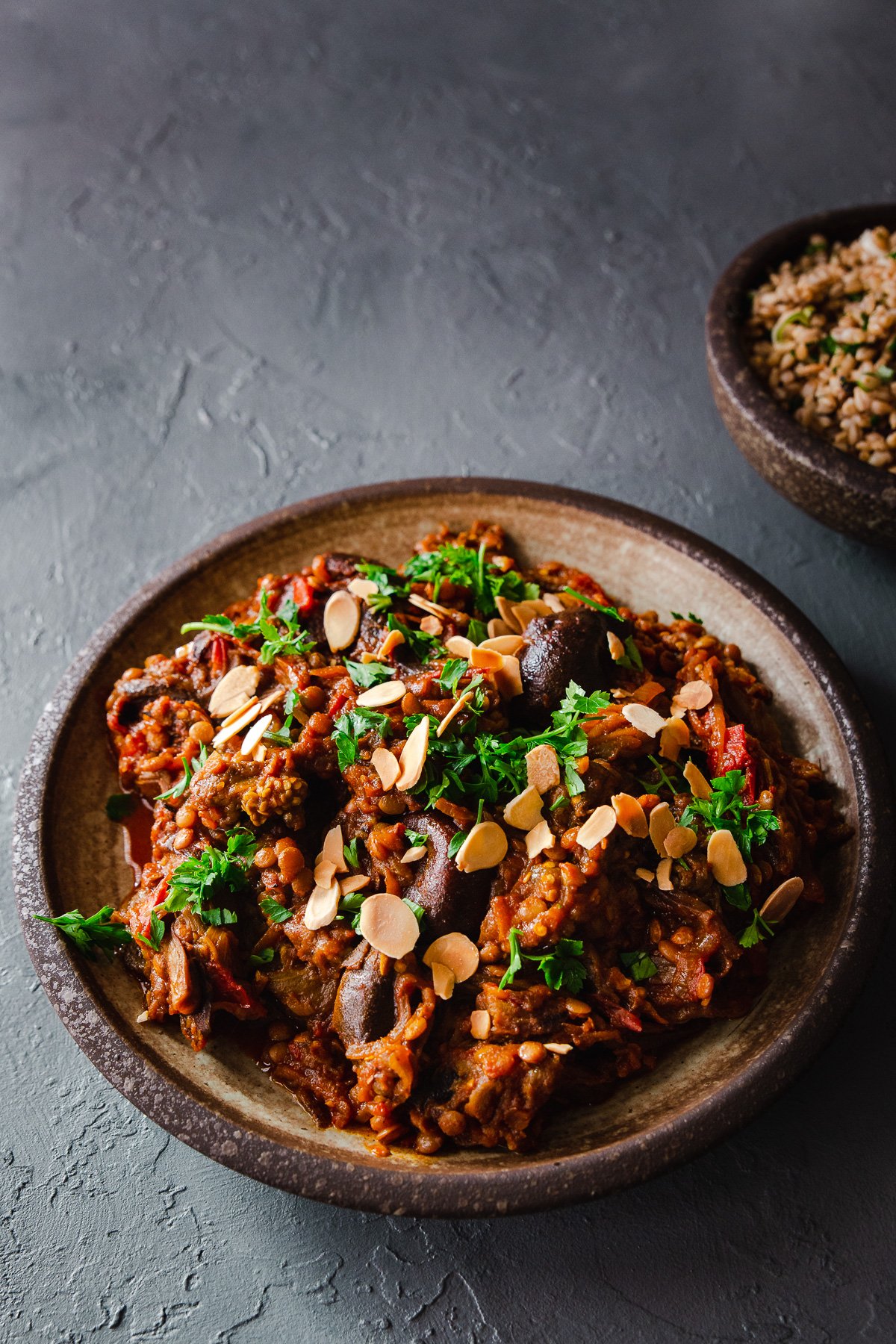
Making aubergine stew ahead of time?
You can make the three main elements (tomato and black lime sauce, baked aubergines, and cooked lentils) a day ahead. Store each in a separate container in the fridge.
Then, continue with the recipe and cook the roasted aubergines in the sauce. It will still require an hour or so of simmering before serving. But, you can be super-organised with little washing up after dinner.
Alternatively, cook the aubergine stew according to the recipe. And store the finished stew in an airtight container in the fridge for up to three days. Gently reheat it before serving.
Or freeze the aubergine stew in portions for an emergency midweek meal.
Don’t remove the dried limes before storing – let the globes hang around to release more of their citrusy flavour.
Leftover eggplant stew is magical with a fried egg and an extra sprinkle of ground black lime – think aubergine shakshuka.
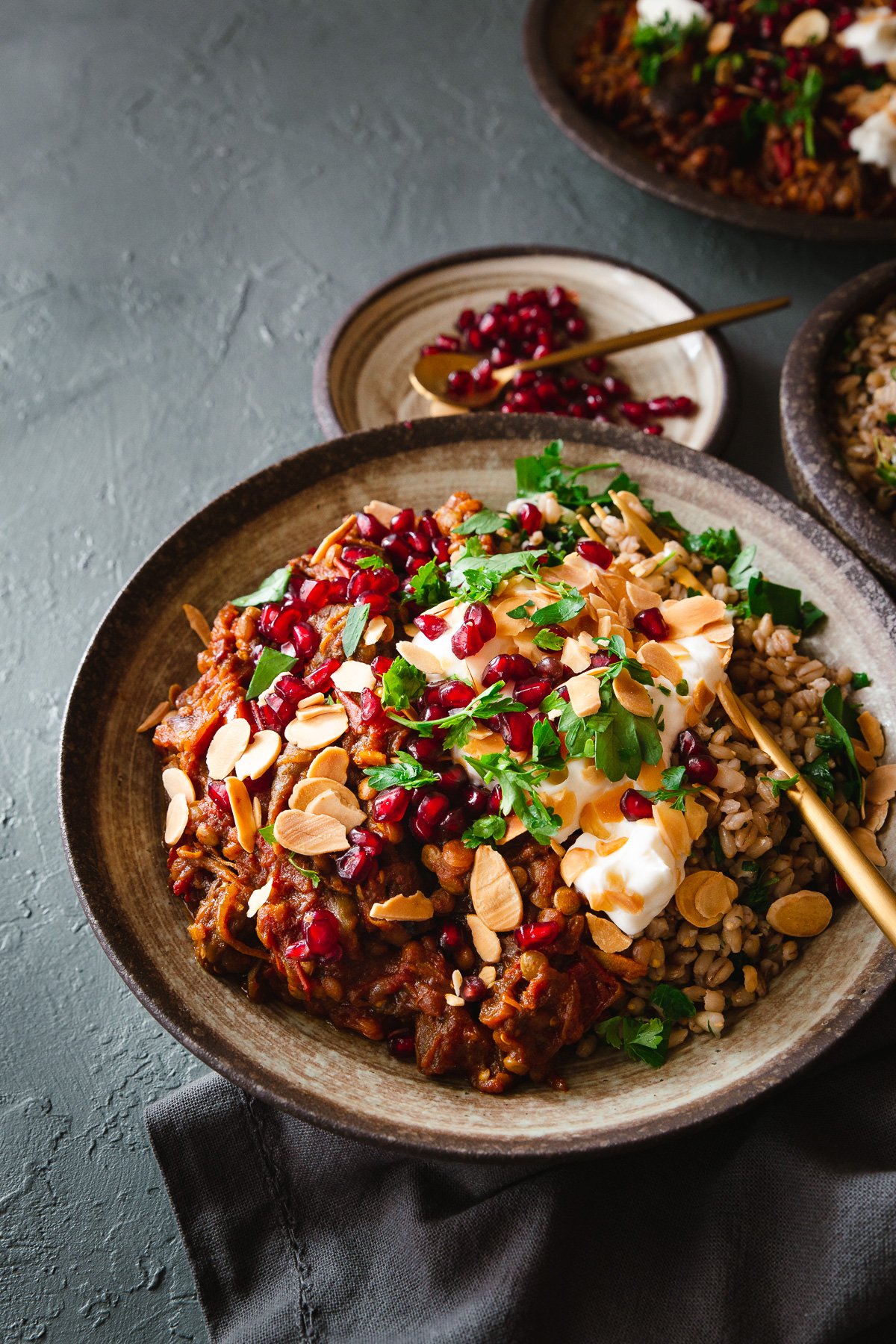
Serving Suggestions
The stew is delicious as is, but you can make it your own with some toppings. It turns the simple stew into a lavish and exciting meal – visually and texturally.
Transfer your aubergine stew to a large serving bowl and top it with:
- yoghurt (choose a plant-based option to keep this meal vegan if you prefer), a dollop of crème fraîche, or feta cheese (or serve it alongside mast-o khiar instead),
- chopped soft herbs such as coriander, parsley or chives,
- toasted almond flakes or slivers, and
- pomegranate rubies.
Serve the aubergine stew alongside:
- fluffy flatbread (like these easy no-yeast yoghurt flatbreads) or toasted pita triangles, and
- mast-o khiar (Persian cucumber yoghurt side), or
- a zesty Arabic chopped salad.
Or, if you’re feeling virtuous, ladle the black-lime-infused stew onto cooked grains for a delicious and healthy vegan meal. I love the nuttiness of pearl barley, but long-grain rice, couscous or bulgur wheat are also perfect.
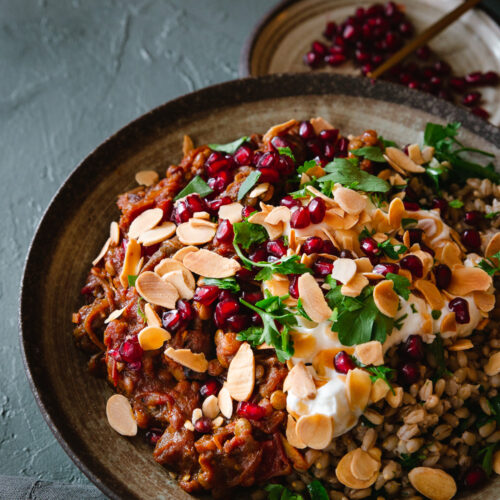
Equipment
- Mandolin – Or a sharp knife.
- Braiser / Buffet casserole – I use a 5-quart (3.5-litre) enamel-coated cast iron braiser. But a deep frying pan or sauté pan is also perfectly fine.
Ingredients
- 2 pounds aubergines (eggplant), peeled, ends trimmed, and cut into large wedges (about 4 medium-sized aubergines)
- 3 cups boiling water, or light vegetable stock
- 3 black limes, or 2 tablespoons fresh lime juice
- 6 tablespoons olive oil
- 2 medium onions, very thinly sliced
- 4 cloves garlic, minced
- 1 tablespoon ground cumin
- 1 heaped teaspoon ground turmeric
- 1 teaspoon cinnamon
- 4 tablespoons tomato paste
- 4 ripe Roma tomatoes, diced
- ⅓ cup uncooked brown or green lentils
- sea salt
- black pepper
To Serve (optional):
- cooked rice / barley / flatbread
- yoghurt
- flaked almonds, toasted
- coriander leaves
- pomegranate seeds
Instructions
- Preheat the oven to 480 °F.
Soak the black limes
- Add 3 cups of boiling water (or warm vegetable stock) to a heatproof bowl. Add the black limes to soften and soak while you start with the aubergines and sauce.
Roast the aubergine wedges
- In a large bowl, mix the aubergine wedges with 4 tablespoons of olive oil, 1 teaspoon of salt and a good grind of black pepper.
- Arrange the wedges on a baking sheet lined with parchment paper, allowing space between the wedges. Use two trays if necessary. Roast for 25 minutes or until the wedges are golden brown and completely soft. Flip the wedges once or twice throughout the cooking process.
Soften the thinly sliced onions
- While the aubergines roast, place a large high-sided sauté pan or braiser on medium heat. Add 2 tablespoons of olive oil with the onions and gently cook for 15 minutes until they are soft and golden (not dark brown), stirring every few minutes. Turn down the heat if the onions start to brown.
Cook the dried lentils
- Place the lentils in a small pot with 1 litre of cold water. Bring to a boil over high heat with the lid on. Once boiling, remove the lid and maintain a simmer. Cook for about 10 minutes until the lentils are cooked but still retain a nice bite.
Build the tomato and black lime sauce
- Once your onions are soft and caramelised, add the minced garlic and cook for a couple of minutes until fragrant (about 3 minutes) – stir frequently.
- Add the spices and stir continuously for 30 seconds.
- Next, add the tomato paste and stir to coat the onions.
- And finally, add the chopped Roma tomatoes and cook until they start to fall apart and form a thick sauce. It should take about 5 minutes.
- Remove the softened black limes from the soaking liquid and pierce them a few times with a sharp pairing knife. Add the pierced black limes and the soaking liquid to the tomato sauce. The limes should be mostly covered, depending on the size of your pan. (If you substitute lime juice for the black limes, only add it at the end of cooking.)
- Bring the sauce to a simmer. Gently push down on the dried limes from time to time. If you have the time, allow the sauce to simmer gently for 20 minutes before adding the roasted aubergines, but you can skip this simmer if you don't. Stir in a teaspoon of sea salt.
Add the aubergine and lentils to the sauce
- Nestle the cooked eggplant wedges in the sauce and season lightly with ground sea salt. Simmer without a lid – gently stirring now and then – until the sauce is thick and the stew creamy in texture, about 40 to 50 minutes. Add a splash of water if the stew looks dry.
- Gently stir in the cooked lentils and heat through. If you did not add black limes, add your fresh lime juice now. Add plenty of pepper. And season with more salt according to taste.
Serve and enjoy
- Serve the stew on rice or barley and top with dollops of yoghurt, toasted almond slices and pomegranate rubies. Or grab some fluffy flatbreads or toasted pita triangles to scoop up the creamy aubergine stew.
Notes
- Can’t find dried limes? No problem! You can absolutely make your own at home. Or substitute with fresh lime juice at the end of cooking.
- If your flaked almonds are raw, flip the parchment paper after roasting the aubergines and reuse it to quickly toast your almonds while the oven is still hot, reducing the oven temperature to 340 °F (170 °C). It should take about 10 minutes. Put it aside until needed.
- The three main components of the stew (roast aubergine, cooked lentils, and tomato-black-lime sauce) can be made ahead and stored in the fridge in separate containers. Continue the recipe where you add the aubergines to the sauce. Alternatively, cook the stew and refrigerate it for up to three days in an airtight container.
- See how to cook barley for Instant Pot and stovetop instructions if you want to serve the stew with pearl barley.
More recipes with black limes
- Harissa shakshuka with black lime marinated feta
- Artichoke salad with goat’s cheese and black lime yoghurt dressing
- Tomato pomegranate salad with black lime dressing
See how to make black limes at home. It’s easier than you think!

I made this recently and it is very good. The black lime gives it a really different and delicious flavor. I was using powdered black lime so had to make some adjustments but in the end it all worked out.
Hi Cathy,
Thank you so much for popping in.
I’m thrilled that you enjoyed this recipe! And happy to hear that the ground black lime worked well. Black lime is such an unusual (and delightful) ingredient, I just love it!
This is very good, I especially like the texture of pomegranate seeds mixed with the aubergines, and the tanginess of the black limes.
Thank you, Wally! I’m happy to hear you enjoyed it. This is one of my all-time favourite recipes for precisely those reasons!
Just about to start this gorgeous looking dish but just wanted to check about peeling the aubergines. I’ve never peeled them before when I’ve cooked them, can you leave skins on or do they definitely need peeling?
Thanks
Hi Jeanette,
You can peel the aubergines with a speed peeler – or how you prefer to peel other veggies like carrots or potatoes. It’s very easy to do, and you don’t have to be too precise. Some remaining pieces of skin are perfectly fine.
But you can leave the skins on if you don’t want to peel the aubergines. I’ve made it with and without skins. I just prefer it without the skins, as the aubergines become soft and velvety.
Let me know if you have more questions!
Fabulous! I can’t believe this has no meat in it! It is so flavourful!
Thank you, Sarah! I also love how flavourful and meaty these aubergines turn out!